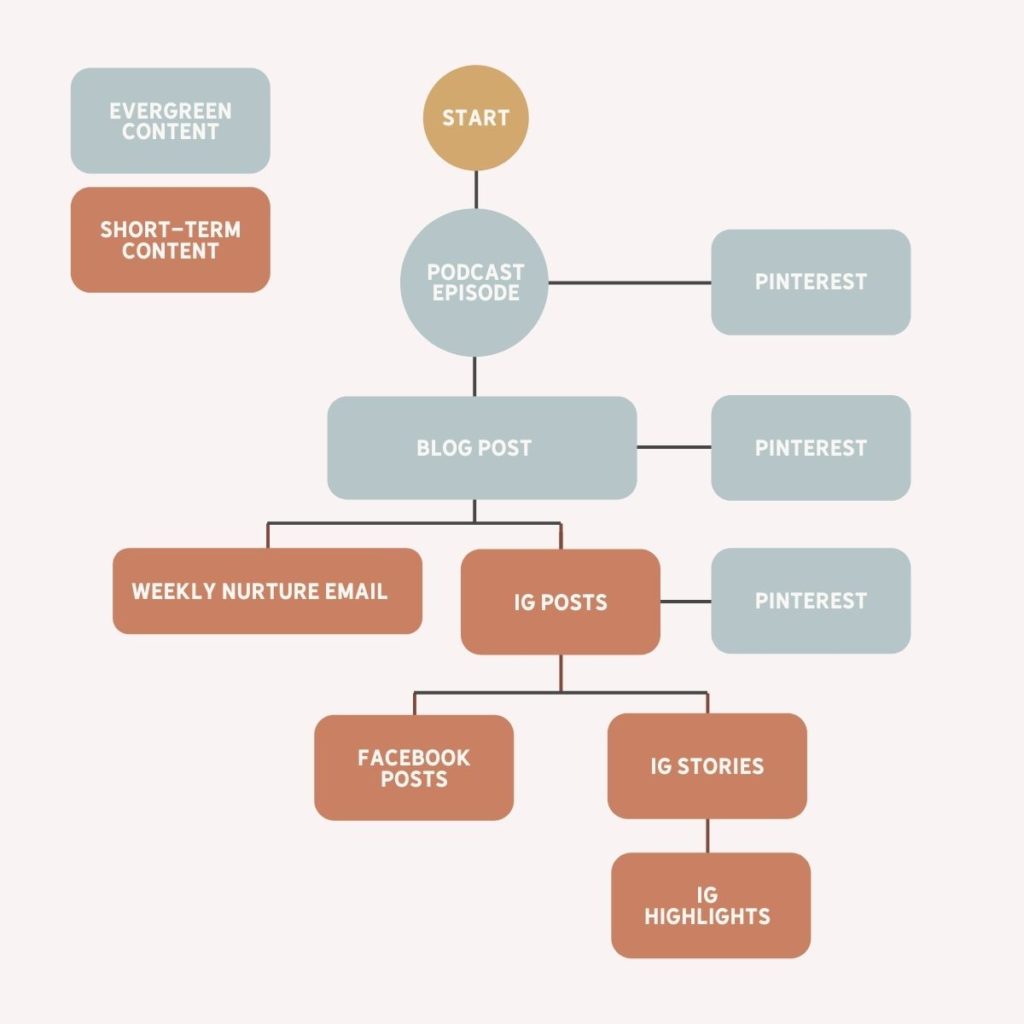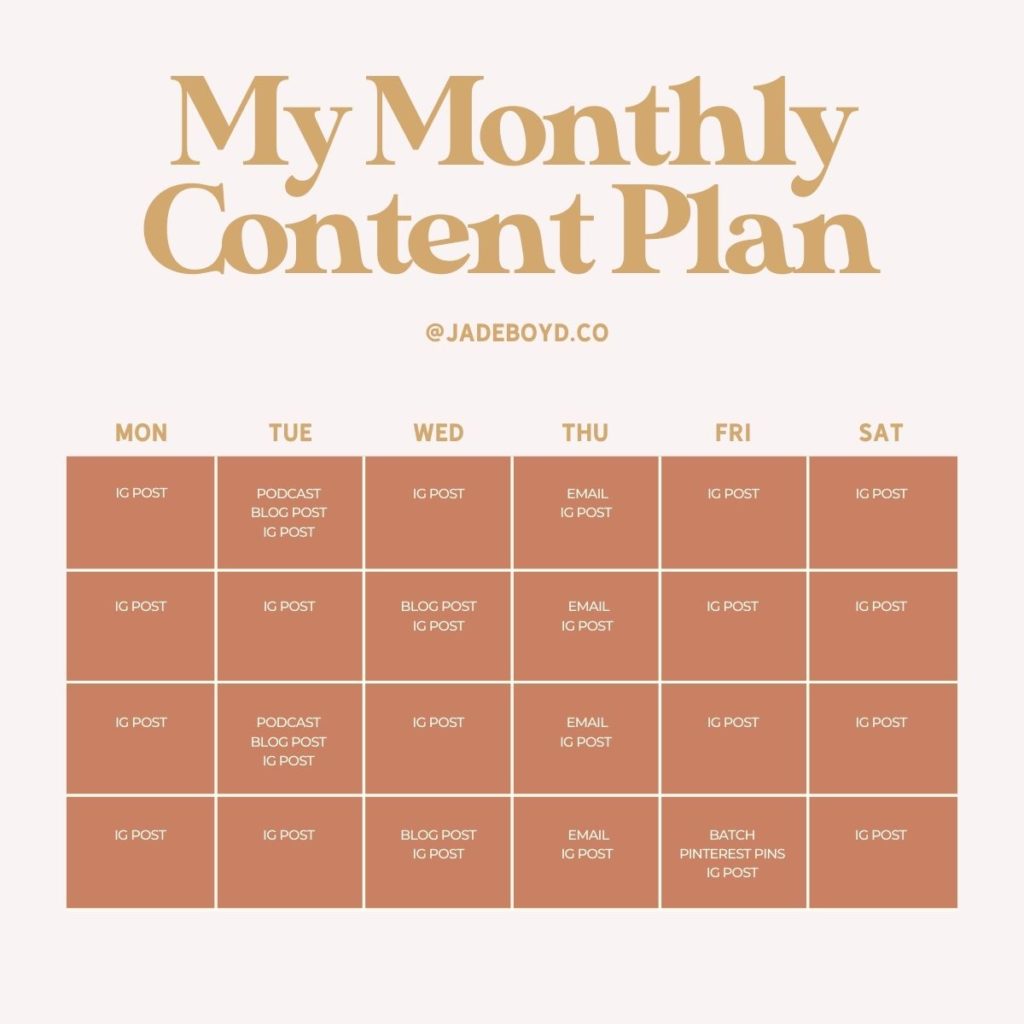Apple Podcasts | Spotify
The content struggle is REAL for so many small business owners. And I get it – as a creative entrepreneur, it’s so hard to show up day after day and create brand building content.
But in order to get consistent leads for your business, it’s so important to create strategic, brand-building content to nurture and engage your audience!
I’ve built my personal brand by using this monthly content planning strategy, and I’m taking you behind the scenes to show you my process.
In this podcast episode, I’ll teach you how to take your marketing content from scattered and unfocused to organized and strategic. Learn how to organize your content plan so you can show up consistently without burning out on the content wheel – let’s dive in!

01 | Create a Content Strategy [1:52]
A lot of creatives skip this part, but it’s so important! A content strategy is your plan for how your content will help you reach your business goals. A good content strategy will attract your ideal clients and keep them engaged until they’re ready to make a purchase. You’ll need to get clear on the big picture to make sure each piece of content is aligned to your brand and business goals.
Start by answering these questions:
- What are your content goals? How do you want your content to support your business goals? Do you want to grow an audience for a future launch? Generate consistent high-quality leads? Generate direct revenue? Get clear on the results you want your content to get for your business.
- Who’s your ideal client? Get familiar with the words they use, the content they consume, the things they search for online, the questions they’re asking, and where they hang out online. The more you know about your ideal client, the better you’ll be able to pull them into your audience with your content.
- What problem does your brand solve? You may have products and services that solve different problems for your ideal client, but get clear on the overall problem you want to lay claim to. When people think of this ONE problem, they’ll think of your brand first. Ideally, you’ll solve parts of this problem in your free content to give your potential clients a taste of what you have to offer.
- What’s your signature offering? This is your main service offer that you want to drive traffic too. Typically, this will be a highly profitable product or service that you offer year-round.
- What are your calls to action? You may have secondary marketing goals like building your email list or pulling people into your audience with low-ticket launches – list them all and clarify how you want people to engage with your content.
“A smart content plan will help you reach your business goals. So you have to know how your content is fitting into the bigger picture of building your business, whether that’s building your audience, or generating leads, or booking clients.
-Jade Boyd

02 | Choose 5-7 Content Pillars [7:31]
Choose 5-7 content pillars that will keep your potential clients engaged until they’re ready to buy from you. Ideally, these content pillars will also help you build your personal brand too! I’m a huge proponent of personal branding because it helps you build trust with your audience faster, and it also allows you to pivot your brand more easily as your business grows and changes.
To narrow in on which content pillars are best for your brand, answer these questions:
- What types of content have performed best in the past?
- What does your audience want to see more of? (hint, hint, you can ask them!)
- What do you want to build your personal brand around? It’s okay to talk about things that are outside your niche as long as your audience can relate or get value from those topics.
- What are the topics you could talk about for hours without getting bored?
As long as your content pillars are adding value for your ideal client, they’re fair game. Think about the different ways that you can educate, encourage, engage, and entertain them that are in line with what you want your personal brand to be recognized for.
As a Brand Photographer and Marketing Strategist, I have five content pillars:
- Personal: If you’re trying to build your personal brand, you have to share who you really are to build an authentic connection with your audience. I frequently talk about our home renovation projects, share personal stories and reflections, and talk about being an enneagram 1 and planner freak. Low and behold, this content gets some of the highest engagement on social media!
- Marketing and Branding: I give my audience helpful advice on how to build a personal brand and market with ease.
- Productivity: This is my superpower that I’ve come to be known for (because I talk about it all the time!), and it’s also really helpful information for creative entrepreneurs (my ideal clients)! From systems and workflows to routines and habits, I am productivity obsessed. I also help my clients put marketing systems into place that help them ditch the busy work and step into their CEO role, so incorporating productivity tips and resources into my content is helping me become known in this industry. I also have a dream of launching a planner company in the future, so building a following in this space will support my long-term business goals too.
- Clients: If you’re a service-based business owner, you should be talking about your client wins at least weekly! This content varies from sharing brand photos, client testimonials, behind the scenes content, or directly featuring products or services.
- For Entrepreneurs: This is a general category for miscellaneous inspirational quotes, words of advice, and relatable content that would engage my ideal clients.
“The simpler your messaging is, the stronger it is, and the more memorable and recognizable your content will be. If you’re hitting those same topics over and over again, you become known for those topics and that’s really the goal here.”
Jade Boyd
03 | Pick a Primary Content Platform [15:31]
Instead of creating new content for every platform, create primarily for one content platform and repurpose it on your other platforms. For your primary content platform, think evergreen.
Evergreen content is search-optimized content that will be relevant for years to come. Evergreen content usually takes the form of long-form content (YouTube videos, Podcast episodes, Blog Posts) that can be discovered over a long period of time.
If you start with a high-value piece of content, you’ll save loads of time by repurposing that content over weeks or months to come.
But you also need to make sure your ideal client is engaged on that platform, and you’ll like creating content for that platform! For example, I hate being on video (and have no idea how to edit it), so it wouldn’t make sense for me to base my entire content strategy on my ability to create high-quality video content for YouTube.

04 | Create a Repeatable Monthly Content Plan [24:36]
Now that you have brand-building content topics and a primary content platform, it’s time to decide how and when to share your content.
Make sure you build a content plan that you can execute consistently! It’s okay to start small with one evergreen content piece per month. Then repurpose that content throughout the month and fill in the gaps with content that aligns to your content pillars.
Currently, I’m creating two podcast episodes and 4 blog posts per month. Then I’m repurposing that content for my other marketing channels.

05 | Record and Organize your Content Ideas in One Place [27:53]
Here’s my number one secret to showing up with great content consistently – record all of your content ideas in ONE place and categorize them by your content pillars.
I organize all of my content ideas in ClickUp. My Organize your Business Template and mini course will teach you exactly how to record your ideas and organize them by content channel and by content pillar. I even share my content workflows and favorite ClickUp automations to save you time!
If you’re not using a task management software, you can record your ideas in your notes app. The key is to make sure you’re able to write down your ideas wherever you are – you never know when inspiration will strike!

06 | Plan your Content Calendar each Month [30:05]
Each month, plan a content calendar that’s aligned to your goals. Choose one to three goals for your business each month, and build a content calendar that pulls potential clients in, nurtures them, and calls them to take action by buying your products or services! If you have multiple goals, I’d suggest focusing on only ONE per week.
If you’re able to plan your content calendar a few months or even a year in advance, that’s even better! But planning at least one month at a time will allow you to batch some content and save time.
Here are some things you may want to schedule in first:
- Launch dates and campaigns
- Behind the scenes content you want to showcase while it’s happening
- Personal events like a business anniversary or employee birthday you want to celebrate with your audience
- Any other date specific happenings you want to share
Once you’ve mapped out the big picture, it’s time to fill in the blanks.

07 | Fill in Your Content Calendar [32:55]
This is the best part in my opinion! Pull together a cohesive content calendar by choosing content topics that align with your business goals and brand strategy.
For example, if you’re launching a Brand Strategy VIP Day, you could record an evergreen podcast episode for “How to Find Your Ideal Client”. Then you can then repurpose that content to build trust and credibility in this specific topic, nurturing your audience until it’s time to ask for the sale.
After you schedule in your pillar content and how you’ll repurpose it, fill in the gaps in your monthly calendar with content ideas pulled from your brand-building content bank.
Voila! You just planned a month (or more) of brand-building content with ease.
Ready to Build a Sustainable Marketing Strategy?
I’m passionate about helping busy creatives simplify and scale their service-based businesses with smart marketing strategies and seamless systems. Follow me @jadeboyd.co for more business and productivity tips!
[…] How I Plan My Monthly Content […]